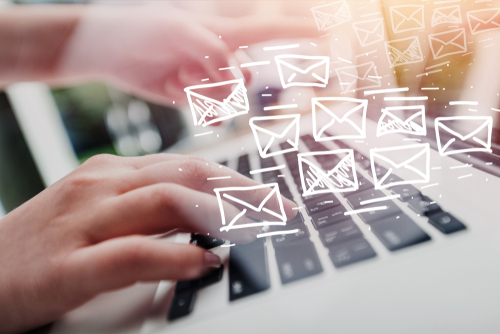 Reading Time: 4 minutes
Reading Time: 4 minutesEmails can be a powerful marketing tool – which is exactly why so many companies take advantage of it. The drawback is that since so many businesses send out emails, recipients often have too many messages filling their inboxes day after day. And while it would be nice for marketers if customers opened every single email they received and read it all the way through, that’s often not the case.
Many emails end up heading straight for the trash, or they are read without the customer taking any action. To help your messages stand out from the rest, try incorporating these email marketing best practices into your marketing strategy.
- Writing Effective Subject Lines
Before a reader even gets to the content inside your email, they encounter your subject line. This is the key to getting recipients to open your email to see what’s inside. An unappealing subject line can mean your message goes unread. The key is to not be afraid to get creative with your choices. Trying to switch up your tone, word count, capitalization, and punctuation can potentially bring better results.
The Hustle is a great example of using effective subject lines. A newsletter focused on tech and business news, the Hustle focuses on a casual, witty tone in their emails. This translates to their subject lines, such as “Cat videos for all mankind” on a newsletter about satellite internet developments. Even if talking about cat videos doesn’t suit your brand, you can still appeal to your reader’s interests.
- Setting Up the Message’s Flow
When arranging content within your emails, you want to set up a flow that makes it easy for your reader to see everything you want them to see. Aside from preventing confusion, having a flow can pull a customer in, guiding them all the way through to the end of your email. Since English reads left to right, you’ll do best if you make it easy to follow that flow throughout the email. Pictures can also help guide your reader’s attention.
With a banner and call to action at the top, you have a formula for success. Take this Duffy’s email for example, which shows off their menu items in the same flow you would experience at a restaurant.
- Personalizing Content for your Clients
Customization is essential for any email marketing strategy – or marketing strategies in general. While there are numerous ways that you can personalize messages, some of the simplest ways are to refer to the customer you’re trying to reach out to.
For example, Airbnb’s messages include both a customized name and location field. While these types of substitutions are easy to accomplish in emails, they can have a big impact on your readers. When combined with further customized content (such as Airbnb’s travel suggestions based on where other people from your location are traveling), you can enhance your customer experience.
- Focusing Your Purpose
While you may want to show off every possible aspect of your business in an email, giving customers too much to do often means that they won’t do anything at all. Instead, you should focus your email on one action, and save the rest for later campaigns. That way your customer has a clear idea of what to do next.
Snagit’s welcome messages are a great example of focused purpose. Since their tools allow users to capture image and video from their computer screens, the welcome message includes a video on how to start using the product, along with a short description and a button that encourages users to learn more.
- Leverage Testing
Testing isn’t just for your web pages; you can do the same with your email campaigns. It’s easy to try out different email strategies and see how they impact your email conversions. Try routinely adjusting the subject lines, layouts, CTAs, copy, and other aspects of your emails. You can make changes over time or even send variations of the same email to different customers to see which give the best results.
- Keep Branding and Design Consistent
Your emails should match the rest of your branding design to make them easily recognizable to your readers. Aside from using your same logo, you can also incorporate a header that looks the same as your website experience. Take advantage of the colors and images to catch the reader’s attention, plus minimal text provides information while being easily skimmable.
- Use Roundup Emails to Save Time
If you don’t have the time to create regular emails or your audience doesn’t have the time to read a message from you every week, you can consider roundup emails. These emails display several options for content, giving your readers the option to pick out what interests them. Both Medium and HubSpot use this method, giving a roundup of blog and article topics, and the layout also works for showing off deals you may have in your store. When combined with personalization, you can give your readers worthwhile content to catch their interest.
- Send Re-Engagement Emails
Even if someone signs up for your mailing list, it can be easy for your messages to fall by the wayside. Sometimes the problem is in how you’re building your emails, and the reader has simply become disengaged. A re-engagement email can outline what’s in it for your subscribers and invite them to stay on your mailing list. Autopilot makes use of these messages to make sure readers are still interested – and if a reader opts out, you can focus your efforts on your interested subscribers.
- Writing Effective CTAs
Your call to action is what will spur your readers to take advantage of whatever you’re offering in your email, but it can be tricky to make an effective CTA. In terms of design, you’ll want the CTA to be large enough to catch your reader’s attention, but not so big that it takes over the entire message. Placing the CTA above the fold is also important.
Michaels has an effective CTA in this sales recap email. Not only does it stand out on the page, have a clear course of action, and pairs well with the image, it uses one of the most basic tactics: the fear of missing out. When you trigger this reaction in your readers, it can spur them to follow your CTA through.
- Celebrate Special Events
The holidays are an obvious time for your email marketing campaign to launch deals, but that’s not the only time you can do it. You can celebrate your business’s founding with deals, and customers also look forward to receiving special deals for their birthdays. You can also send messages like this TheSkimm email, which celebrates the date a subscriber joined the email list.
These email marketing examples are just some of the best practices you can use while developing your campaigns. With the right approach, you can create a winning email marketing strategy and boost reader engagement.




